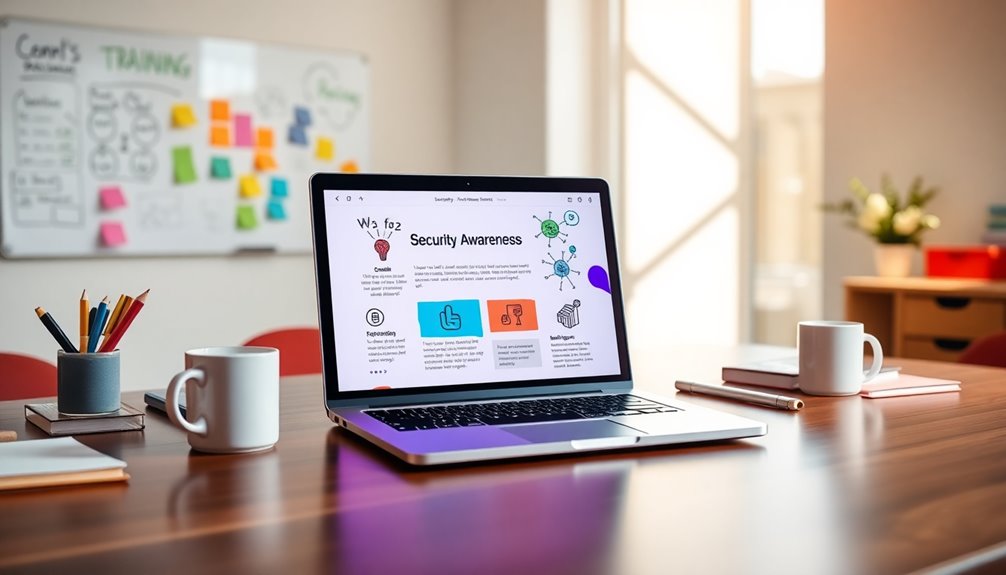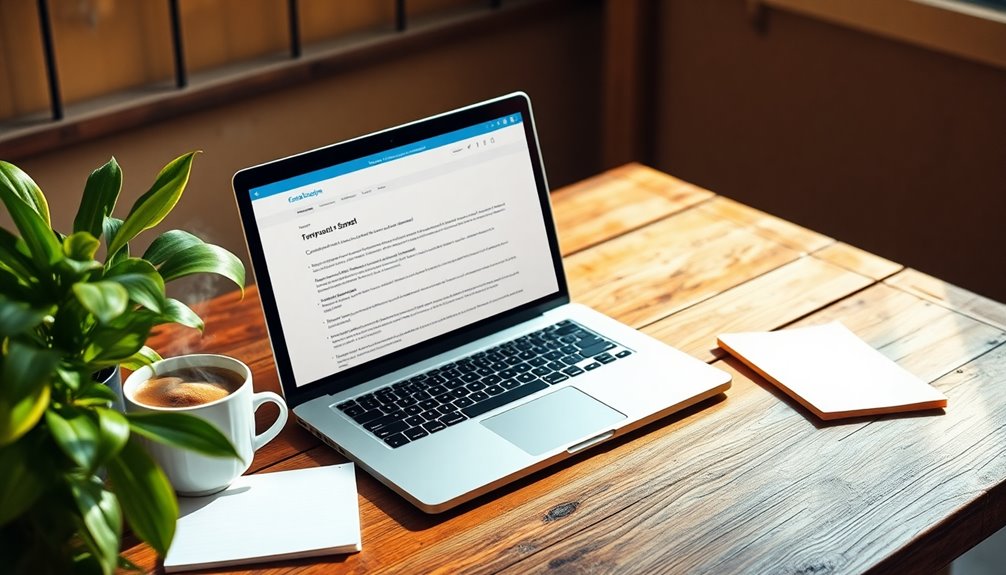To write an email to your teacher about something important, start with a clear subject line that reflects the content, like "Request for Extension on Assignment." In the body, briefly introduce yourself with your full name and class. Clearly state your request and include any relevant details, being polite and respectful throughout. Express gratitude for their time and consideration. Avoid overwhelming them with multiple requests in one email. If you don't hear back within a week, consider a polite follow-up. These steps can help you craft a professional and effective email that captures their attention. Want to learn more tips?
Key Takeaways
- Start with a clear and concise subject line that reflects your request's purpose.
- Include your full name and class to help the teacher identify you.
- Clearly state your request along with any relevant details or deadlines.
- Maintain a polite and respectful tone throughout your email.
- Express gratitude for the teacher's time and consideration at the end of your message.
Introduction

When reaching out to a teacher via email, clarity is key. Start with a clear subject line that indicates the purpose of your request. For instance, if you need an extension on an assignment, a subject like "Request for Extension on Assignment" will immediately inform your professor of your email's intent.
Next, introduce yourself briefly. Include your full name and the class you're enrolled in to provide context. This helps the teacher quickly recognize who you are, especially if they manage multiple courses and students.
Then, clearly and concisely state the reason for your request. Avoid unnecessary details, but do provide any background information that may help your professor understand your situation.
Establishes Clear Communication Channels

Clear communication channels through email are vital for effective interactions between students and teachers. When you email your professor about important matters, you want to ensure your message is clear and direct. A well-structured email not only addresses your specific concerns but also serves as a formal record of communication. This record can be invaluable for both you and your teacher for future discussions or follow-ups.
Using a specific subject line helps your professor quickly identify the purpose of your email, allowing them to prioritize and respond effectively. For example, instead of a vague subject line like "Question," try something more specific like "Request for Extension on Assignment Due Date." This clarity aids your teacher in understanding your request and increases the likelihood of a timely response.
Additionally, maintaining a professional tone in your email fosters respect and encourages a positive relationship. Including relevant context, such as class details or assignment titles, further enhances the communication.
Concise Subject Line

Crafting a concise subject line is essential for effective communication with your teacher. A clear subject not only indicates the purpose of your email but also helps your teacher prioritize their responses. Instead of vague phrases like "Hi" or "Important," opt for something specific, such as "Request for Extension on Assignment Due Date." This approach demonstrates professional email etiquette and ensures your message isn't overlooked.
Incorporating relevant keywords related to your email's content, like the course name or specific topic, can enhance visibility. A well-defined subject line, ideally under 10 words, makes it easy for your teacher to grasp the email's intent at a glance. This allows them to quickly assess the urgency and relevance of your request, boosting the likelihood of a prompt response. Additionally, a strong subject line contributes to building topical authority, which can enhance overall communication effectiveness.
Step-by-Step Guide to Requesting Assistance

Requesting assistance from your teacher can feel daunting, but following a structured approach can make it easier. Start with a clear subject line, like "Request for Assistance with Biology Project." This sets the tone for your email and helps your teacher identify the purpose right away.
Next, introduce yourself. Include your full name and class information so the teacher can quickly understand who you are.
After that, get specific about your request. Whether you need clarification on an assignment or want to request an extension, provide relevant details and deadlines to give context.
Remember to maintain a respectful and polite tone throughout your email. Express gratitude for your teacher's time and consideration, which shows you value their help. For instance, you might say, "Thank you for considering my request."
Dos and Don'ts for Requests

When reaching out to your teacher, knowing the dos and don'ts can make a significant difference in how your request is received.
First, do express gratitude; a simple "thank you" can go a long way in showing appreciation for your teacher's time and effort. It creates a positive tone and encourages a more favorable response.
Next, be specific and clear in your request. Instead of saying, "Can you help me?" specify exactly what you need, like "Could you provide clarification on the grading criteria for the upcoming project?" This clarity helps your teacher understand your needs better and respond appropriately.
On the other hand, don't overwhelm your teacher with multiple requests in one email. Focus on one main question or issue to avoid confusion and increase the chances of a prompt reply.
If you haven't received a response within a week, do follow up politely. Reference your initial email, reminding your teacher of your request while maintaining a respectful tone. This shows you're proactive without being pushy, and it helps keep your inquiry on their radar.
Examples of Request Emails

Lastly, if you need to schedule an appointment, suggest a few available times.
You could write, "I'd like to discuss my recent project. I'm available this Thursday at 3 PM or Friday at 1 PM. Please let me know what works for you."
Each example shows respect for your teacher's time while clearly stating your needs.
Pro Tips for Writing Effective Emails

Crafting an effective email to your teacher can make a significant difference in how your request is received. Start with a clear subject line that directly reflects your email's content, like "Request for Extension on Assignment Due Date." This grabs your teacher's attention right away.
Follow up with a professional salutation, such as "Dear Professor Smith," to set a respectful tone. Early in your email, introduce yourself by stating your full name and class information. This context helps your teacher quickly identify you among their students.
When writing, keep your email concise and focused. Stick to the point, providing any necessary details or context clearly. Consider utilizing email best practices to ensure your message is well-received and effective.
Avoid lengthy explanations that could lead to confusion or require back-and-forth communication.
Final Thoughts

While sending an email to your teacher might seem straightforward, taking the time to do it right can lead to better communication and outcomes. Start with a clear subject that highlights the importance of your request. This way, your teacher knows exactly what to expect when they see your email.
Introduce yourself clearly by including your full name and class information. This context helps your teacher respond more efficiently.
Remember, maintaining a polite and respectful tone throughout your email is crucial. Express your gratitude for their time and assistance, which fosters a positive relationship.
Be specific about your request; include any necessary details to minimize back-and-forth communication. This consideration respects your teacher's busy schedule and shows that you value their time.
When you're wrapping up, don't forget to include a polite sign-off along with your full name. This reinforces the importance of your request and your appreciation for their help.
Frequently Asked Questions
How Do I Write an Email to a Teacher Asking for Something?
When you write an email to a teacher asking for something, start with a clear subject line that reflects your request.
Address them respectfully by their title and introduce yourself, mentioning your full name and class.
Clearly state your request and provide any necessary details to help them understand your situation.
How Do You Write a Good Email Asking for Something?
To write a good email asking for something, start with a clear subject line that captures your request.
Introduce yourself briefly to give context.
State your request clearly and provide any necessary details to avoid confusion.
Keep your tone respectful and polite, expressing gratitude for the recipient's time.
How Do You Write an Email to a Teacher About a Concern?
To write an email to a teacher about a concern, start with a clear subject line that reflects your issue.
Introduce yourself by stating your full name and the class you're discussing.
Clearly express your concern in a respectful way, providing any necessary background details.
Keep a polite tone, showing appreciation for the teacher's time.
Conclude with a courteous closing statement and a professional sign-off, including your full name for clarity.
How Do You Write a Letter to Your Teacher Asking for Help?
When you write a letter to your teacher asking for help, start with a clear subject that reflects your request.
Use a respectful salutation and introduce yourself, mentioning your full name and class.
Clearly explain what you need assistance with, providing any necessary details.
Make sure to express gratitude for their time and support.









